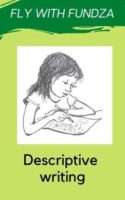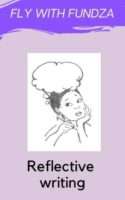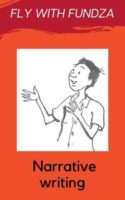There is a lovely quote: Reading is breathing in, and writing is breathing out.
Although the focus in reading clubs is, of course, reading, there is also place for writing too! Writing can be an easy way to make sure that everyone express thoughts and opinions about what they read. And, more than that, writing can develop thinking and creativity.
As teachers we often focus on writing being ‘wrong’ or ‘right.. And obviously we do want learners to improve their writing. But, if you are a teacher, how many of your learners take their essay with all your careful corrections, and study them to improve for next time? And those of you who are reading group facilitators, think back: how many of you, when you were learners, looked at all those red marks on your essay and ‘learnt from your mistakes’? An effective way to teach writing is to get learners to read as much as possible, and then get comfortable themselves about using writing as a way to give their own thoughts, rather than as something that is seen as a test, or an evaluation.
Writing can also, in some cases, be therapeutic, and help people get a feeling of control over what happened to them, or help them to understand their thoughts and feelings about a particular topic. However, a warning: used wrongly, writing can also re-traumatise people, and make feel the pain all over again. So it is important that you never force learners to write about a particular topic if it could be too disturbing for them.
Just as there are ways to get learners talking, there are also ways to get learners writing, even those faced with a blank page who say they ‘can’t think of anything to write… A useful technique is ‘Freewriting’.
Freewriting is a very useful technique to get ideas flowing. Learners often start criticising themselves before they even pick up a pen, and don’t know where to start.
Instructions for freewriting:
* There is only one rule for freewriting: don’t stop writing! For a certain period of time, you are not allowed to stop writing. If you can’t think of anything to write, then you just write, I don’t know what to write, until another thought comes to you.
* Draw on all your senses in your freewriting – what you see, hear, taste, touch, smell.
* Give yourself – and your learners – permission to write badly! Freewriting is getting your creative juices going, it is NOT a finished product. No crossing out, going back or reading what you have done till your time is up.
Many writers use freewriting as a way to warm up. What you write can often surprise you as you often become aware of thoughts and ideas that you weren’t conscious of before.
Freewriting is a useful way to ensure that all learners write something – in whatever language they choose. It is not an ‘end product’. Learners should NEVER be forced to share their freewriting. You could possibly ask them to share a sentence, but generally it is best to respect the privacy of the writing. You can ask for volunteers to read out loud if you want, but it should be completely voluntary.
You can use freewriting in class as well in different situations. You can use it to start learners off thinking about an essay topic, or when you have asked a question that nobody is answering – ask them to freewrite the answer for five minutes, and then see if they have some ideas to contribute! Freewriting is effective even if it is done for a short time, so just 5 minutes of freewriting is a useful technique as it ensures that for those concentrated five minutes, learners are truly engaged!
When we use freeewriting in workshops, it is often one of the most highly rated activities.
Here are some quotes from people after freewriting:
“I loved it! It took me back to things I thought I had forgotten about, when I stayed with my gogo.”
“Difficult at first, didn’t know what to write, but then I warmed up. And I went completely off topic – I started writing about my memory and ended up writing about my uncle who is ill.”
“I often use this and write like this in my journal. It helps me calm down.”
Try it yourself to see how it feels. Get a pen, and paper, and put on alarm to ring in 5 minutes. Decide what you are going to start writing about, and go for it until the alarm rings! You could write about a happy childhood memory, for example… Or your feelings about reading and writing. Don’t worry if you go off topic though – that is to be expected!






